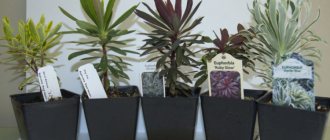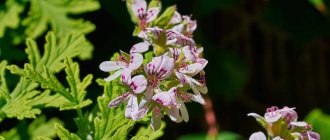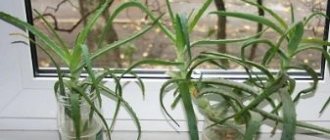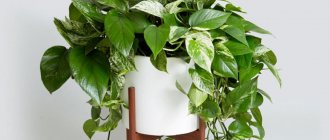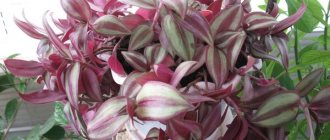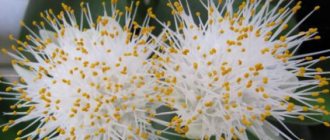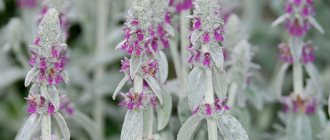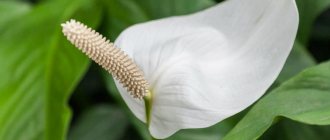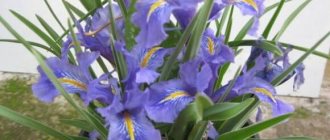Do you want to grow a beautiful indoor Epipremnum flower? Read useful information about this vine in this article.
Indoor flowers decorate our lives. We love to take care of them, watering and replanting, and the plants thank us with their lush flowering and good growth.
Read in another article on our website about the home flower Pedilanthus - care, replanting, signs, benefits and harm to humans .
Creepers are one of the most beautiful indoor flowers. They are easy to grow and do not require much time to care for. Find out more about the indoor flower Epipremnum pinnate, especially if you want to plant it at home. This article describes the proper care of this plant. Read on.
Where is the birthplace of the indoor flower “Epipremnum pinnate”: types, varieties, photos
Indoor flower "Epipremnum pinnate"
Epipremnum (from the Latin Epipremnum, which means "on the trunks", as this is associated with their usual habitat), or it is also called scindapsus. This plant is one of the most popular varieties of perennial vines. Belongs to the Araceae family (from the Latin “ Amorpho ” - “ shapeless ” and “ Phallus ” - “ offspring, shoot ”). Description of indoor flower Epipremnum pinnate :
- Under normal conditions, the flower can reach up to 38-40 meters in length, spread widely on the ground or be attached to the trunks of other trees.
- If we are talking about a home flower, then it can grow up to 4.5 meters long. It is easy to care for, which is a plus for lovers of house plants.
- Every year this plant can add up to 45 cm .
- Blooms only in its natural habitat. This usually happens from spring until late autumn.
- The flowers themselves grow in the form of a cob, so they do not carry any value. They are valued more as decorative.
The tropics of Southeast Asia, namely the Solomon Islands of the Malay Archipelago , as well as Indonesia the birthplace of Epipremnum .
Indoor flower Epipremnum pinnatum (from the Latin Epipremnum pinnatum) is a plant that is a kind of vine, the leaves of which are strewn with various yellow-green spots. Under normal conditions, the stems can easily reach their legal 2 meters in length. They practically don't bloom. More likely, they never even bloom. Look at the photo how beautiful a flower looks when it grows at home:
Indoor flower "Epipremnum pinnate"
Types of indoor epipremnums
Only a few types of epipremnums are compact enough to grow in rooms.
Epipremnum aureum is the most common species with thin shoots up to 2 m long, “equipped” with clinging roots and perfectly heart-shaped leaves, decorated with unevenly appearing golden spots and strokes. The number, size and intensity of the spots depends on the brightness of the lighting.
Epipremnum silvaticum.
The plant has several charming variegated varieties:
- white-cream-lime ' Marble Queen' ,
- small-leaved with contrasting white and emerald spots ' Enjoy',
- large-leaved, with more elongated and pointed, almost entirely yellow leaves of ' Golden Pothos' .
Two green-leaved species of epipremnum are undeservedly deprived of attention. This is a forest epipremnum (Epipremnum silvaticum) with very beautiful glossy leaves up to 20 cm long, a perfect oval-lanceolate shape, with a grooved base and a rich dark forest shade of green.
Epipremnum pinnatum.
And Epipremnum pinnatum with small and wrinkled, densely veined oval-shaped leaves, which become covered with holes with age or are symmetrically divided into lobes. The light matte underside of the leaves emphasizes the beauty of the upper, glossy mirror and dark emerald.
Indoor flower Epipremnum: types and varieties
Indoor flower Epipremnum aureum (from the Latin Epipremnum aureum) is a plant that is most often chosen for growing at home. The stems can reach up to 1-2 meters in length. But this is only under normal conditions. On the stems you can often see greenish leaves with a certain golden tint. It only becomes stronger if the plant is close enough to the light.
Indoor flower Epipremnum
Here is a list of popular varieties of this type:
Epipremnum Golden Pothos
- Golden Pothos - Its leaves are usually yellow-gold in color.
Epipremnum Marble Queen
- Epipremnum Thai Marble Queen - moderately golden, sometimes with a white tint, the relevance is in the white strokes on the leaves.
Epipremnum Enjoy
- Epipremnum Enjoy (joy-n-joy) - its leaves are exclusively green in color, with white streaks and strokes in some cases.
Epipremnum Pearl and Jade
- Epipremnum Pearl and Jade - refers to selection based on the primary Marble Queen, the color of the leaves is always very diverse.
Epipremnum Aureum (aureum)
- Epipremnum Aureum (aureum) - leaves are succulent with yellow splashes. This vine spreads as usual, but the leaves point upward.
Epipremnum Variegate Pinnatum
- Epipremnum Variegata Pinnatum - the leaves are beautiful, large, as if covered with a white mesh.
Epipremnum Happy Leaf
- Epipremnum Happy Leaf is a beautiful indoor vine with white leaves. It looks very stylish and interesting in the house, and perfectly complements the appearance of other green plants.
Epipremnum Skeleton
- Epipremnum Skeleton - its appearance resembles a skeleton. Holes in the leaves look interesting, as nature itself made them.
Epipremnum Godzilla
- Epipremnum Godzilla - When you first see this flower, you might think it has wilted. Its leaves are slightly curled and dark green in color. But it does not fade, this is the usual and normal appearance of the flower of this species. Attracts attention against the background of other indoor plants.
Epipremnum Neon
- Epipremnum Neon is another beautiful variety that stands out from other flowers. The leaves actually seem to glow neon.
Epipremnum maculata
- Epipremnum spotted, or you can also find the name “painted” (from the Latin. Scindapsus pictus) - a vine that grows up to 15 meters . The surface of its stem on a young plant is very smooth, but with increasing age, it begins to form numerous growths. The leaves are ovoid in shape, slightly elongated in length by approximately 12-15 cm , and only 6-7 cm .
Epipremnum Exotica
The most famous varieties at the moment: Argyraeus (silver spots that are scattered very chaotically) and Exotica (leaves with silver dots and strokes, unusual shape).
Features of epipremnum
Epipremnum is a herbaceous evergreen vine that is a perennial. This hemiepiphyte can parasitize large trees or grow independently. Nutrients enter the bush through the fibrous root system. The vine also has a large number of aerial roots; if necessary, they can form an additional root system. There are two types of aerial roots: the first ones grow from nodes and cling to a tree or other support, and the second ones grow from internodes and are aerial feeding roots. Over time, all aerial roots become lignified, while the feeding roots become woody, and on their surface a bark is formed, which consists of ribbon-like fibers, and the supporting ones are cork.
The shoots of such a vine are not only able to cling to almost any support, but can also take root along their entire length. The simple, heart-shaped leaf blades are either leathery or thin. In adult bushes, the foliage is about 0.6 m long and up to 0.4 m wide. However, while the plant is young, its leaf plates are not so large. Over time, the foliage is able to change its solid form to pinnately divided or pinnately dissected. And in some cases, holes may appear in the leaf plates, for example, like in monstera.
During flowering, the vine produces inconspicuous flowers that do not represent any decorative value. The flowers are part of an inflorescence that is shaped like a spadix and tapers towards the apex. And on top it is wrapped in a blanket, which is shaped like a canoe. Such a liana blooms only if its foliage becomes mature, but in indoor conditions this happens extremely rarely, which is why flower growers do not often see epipremnum flowers. The fruit is a berry with seeds inside.
Houseplant Scinapsus or Epipremnum: how to properly care for and propagate
Epipremnum: beneficial properties
Botanical enthusiasts claim that growing epipremnum at home allows you to fill the house with vivacity and excellent mood even on the grayest and rainiest days. Epipremnum has beneficial properties. Here are some scientifically proven facts about this plant:
- It absolutely definitely increases the endurance of the human body just by being nearby.
- It has a stimulating effect on the mind, increases the intensity of its development.
- It has a positive effect on people’s well-being, both on an emotional and physical level.
In addition to the fact that this plant is beautiful, it also has a beneficial effect on humans. However, many people are afraid to grow it at home according to signs. Read on.
Epipremnum: signs
Before reading, we warn you that signs only work with those people who believe in them.
- They say that Epipremnum is the plant that will separate you from your husband. All these plants are very dangerous for those who do not want to live alone all their lives.
- This is also one of those very representatives of the “mozhegons” . If you are single, you will not be able to get married if you have such a flower growing at home.
Still, it’s worth clarifying once again that no flower is to blame for the fact that your personal life is not going well. That's why some people believe in omens, while others don't, and plant such beauty in their homes.
The benefits of epipremnums
Popular rumor does not favor epipremnums, like other indoor vines, attributing to them properties that have nothing to do with reality. And the real benefits of these plants for humans have been proven in scientific research. In 1989, NASA scientists conducted a series of experiments in search of plants that could purify the air in confined spaces of orbital space stations. The effectiveness of different plants in filtering such harmful compounds was tested:
- formaldehyde;
- benzene;
- trichlorethylene.
As a result, a list of indoor plants that can remove these harmful substances from the air was compiled. This list also includes epipremnum aureus , which has shown effectiveness in purifying the air from formaldehyde and benzene. In modern apartments, the concentration of these harmful impurities is much higher than permissible; they are actively released by furniture and finishing materials, which negatively affects the health of residents.
Researchers have found that at 9 sq. m of living space, one medium-sized epipremnum is enough to completely clean the air of benzene and formaldehyde. By the way, chlorophytum crested, widely known for its cleansing properties, absorbs only formaldehyde and is not effective against benzene. At the same time, it should be noted that the sap of plants of this genus is poisonous, like almost all aroids. Therefore, when caring for epipremnum, you need to be careful not to let its juice get on the mucous membranes, and place flowerpots in places inaccessible to pets and small children.
Epipremnum plant: features of growing at home
As mentioned earlier, caring for the Epipremnum is very simple. It is for this reason that this flower can often be found in the houses and apartments of people who are landscaping their “fortress”. Features of growing at home:
- The most important thing is to provide a place where Epipremnum will stand. It should be in diffused lighting, with a pot and soil suitable for its characteristics.
- It is also necessary to ensure optimal temperature and air humidity for the plant, sometimes timely feeding with fertilizers and watering.
- Do not touch the leaves under any circumstances when the flower is dormant, otherwise it may die.
These are the most important requirements for caring for a plant. As you may have noticed, they do not have any special features. Read more about care below.
Epipremnum in the interior
According to the Eastern teachings of Feng Shui, epipremnum pinnate is an accumulator of positive energy in the house. When it is grown for a long time, the health of household members is normalized, physical activity and professional activities are improved. Due to its high decorative and beneficial properties, the plant is often used to decorate private and commercial interiors:
- The vertical axes of shop windows, terraces, foyers and balconies are often decorated with flowers using the ampelous principle.
- A flower in a pot with a special support, which can be covered with moss to maintain an optimal level of humidity, does not lose its decorative effect.
Indoor flower scindapsus Epipremnum: care at home
Indoor flower scindapsus epipremnum
If you have taken up growing an indoor flower scindapsus epipremnum , then you should know the following basics of care at home:
- In summer you need to keep the temperature no higher than 18-24 degrees Celsius , and in winter - no lower than 13 degrees Celsius.
- Air humidity should be high enough. Of course, the plant is drought-resistant, but this does not change the fact that it has a very hard time living in such conditions. It is worth spraying its leaves from time to time so that development and growth remain positive.
- It was mentioned above that this plant feels best in diffused light, but the flower can also adapt to partial shade.
- Water at least once every 5 days in summer, and in winter - at least once a week with warm water.
- The soil should consist of sand, peat, humus and even leaf soil.
- From spring until autumn, it is advisable to feed the plant with various liquid mixtures for indoor plants - once every 3 weeks . There is no need to do this in winter, which is very convenient.
- Replant a young plant annually - in early April, and an adult - once every 2 years .
- It is best to propagate by cuttings. To speed up the process, it is better to use a container of water or a peat mixture with moss.
Important : The plant reacts very painfully to drafts and gases, and also needs support as it grows. It is recommended to carry out pruning in the spring; cut branches only to half their length.
Scindapsus pictus or Scindapsus pictus
A very popular and widespread species.
The adult leaf is matte dark green with a thin white edge. Silvery-white spots of various sizes are scattered across the entire surface of the leaf. A characteristic feature of the species is the asymmetry of the leaves relative to the central vein.
Under good conditions and high humidity, scindapsus leaves can grow up to 15 cm.
Scindapsus pictus
Varieties of scindapsus pictus (painted) :
Scindapsus Argyraeus
A popular variety of scindapsus painted. Wide small leaves with small white spots.
Scindapsus pictus Argyraeus
Scindapsus Pictus Trebie
A common variety - large asymmetrical leaves with a light contrasting pattern - spots, strokes, stripes. The leaf is slightly embossed, the surface of the leaf is velvety. Unpretentious, shade-tolerant, but the brightness of the pattern depends on the intensity and duration of lighting.
Scindapsus pictus Treble
Scindapsus Pictus Silvery Ann or Satin Pothos
Silvery spots almost completely cover the matte green surface of the leaf. Of all the varieties of Scindapsus painted, Silver Ann has the most extensive coverage of spots of the main green background. Sometimes the surface of the sheet appears completely silver.
Scindapsus Pictus Silvery Ann
Blooming liana Epipremnum
As mentioned above, the flowering of the Epipremnum vine is not the main advantage of this plant. It belongs to the Araceae family, which means that, like all other representatives of this family, Epipremnum is characterized by an inflorescence in the form of a spadix, the length of which is no more than 6 cm .
The period of such flowering, specific to us, occurs in the spring-autumn period. This occurs exclusively in wild (natural) conditions. At home, the plant plays the role of a decorative foliage flower.
Transplantation, containers and substrate
This ampelous plant can be grown both in a slightly acidic substrate and in hydroponics. Soil for aroids or a substrate for decorative deciduous crops, to which loosening components have been added, is ideal.
Transplantation of epipremnum is carried out after complete development of the earthen coma in the previous container, using the transshipment method.
Epipremnums do not like containers that are too large; they are grown in compact containers that match the fibrous root system. The width of the pots should exceed their depth. When replanting, containers are increased by no more than 2 cm.
Transplantation is carried out after complete development of the earthen coma in the previous container, using the transshipment method. The ideal time is mid-spring. When transshipment, a high layer of drainage is laid on the bottom.
Temperature regime for the Epipremnum flower when kept at home
The temperature regime of the Epipremnum flower when maintaining a house is very important. He is very sensitive to airflow and loves warmth, but it is also difficult for him to tolerate heat.
In the summer season, the most optimal temperature for the plant is 18-25 degrees Celsius , and the air temperature in winter should not fall below 14 degrees Celsius . This is important, because low temperatures have a very bad effect on the well-being and growth of Epipremnum. Don't forget that the air humidity should also be high.
Diseases, pests and problems in growing epipremnuma
In unsuitable temperatures and with constant poor care, this vine can suffer from rot, spider mites, scale insects, thrips and aphids. When adjacent to infected plants, rust and fungal diseases quickly spread to epipremnums. If any signs of damage are detected, the plant must be immediately isolated and treated with systemic insecticides or fungicides.
Quick and efficient rooting of cuttings makes it easy to propagate and renew epipremnums.
When the soil dries out, especially frequently, the tips and leaves dry out; when the soil becomes waterlogged, the leaves become covered with black spots. Changes in color and loss of patterns always indicate an incorrect choice of lighting.
Spraying the Epipremnum plant
From time to time it is recommended to wipe the leaves with a damp cloth, or give the flower the opportunity to take a full “shower” under running warm water.
Measures such as spraying the plant are usually introduced in particularly hot weather. In summer, Epipremnum needs this procedure every other day or two. Ideally - every day. Such procedures will not be superfluous during the heating season. Especially if you choose a place for the flower near a radiator or some other heating device.
general information
Epipremnum is a liana, and one of the most successfully cultivated. In a natural environment, it grows to a fantastic 40-50 m. Of course, in an apartment the scope is much smaller, but even there it readily entwines itself with any supports and is suitable for green walls.
There are also more compact varieties of epipremnum, which can easily turn into a neat bush. All of them are united by thin, tenacious shoots and beautiful ovoid or heart-shaped leaves with a pointed tip. By the way, in nature it is a semi-epiphyte, which means it can grow separately or on trees.
Photo: viesso.com
Epipremnum: lighting and watering
Epipremnum does not tolerate direct sunlight. The plant will thrive under diffused light and even in twilight (in some cases.)
If you choose between an east and west window, it is better to place it on the windowsill on the east side. But if for some reason you wanted to designate the western window as the flower’s place of residence, then there is nothing wrong with that. The difference is very small, just spray the plant more often if the sun is very bright.
Worth knowing: Do not keep the plant in northern rooms and in rooms with minimal lighting. Shade is normal, but darkness will significantly deteriorate the plant's appearance. For example, the leaves will not be bright and noticeable, and the shoots will be long and begin to creep unattractively to the sides.
As for watering, you should not water the plant too often. The soil should be given time to dry a little. Otherwise, there is a high probability that the roots will begin to rot. A moisture-absorbing, heavy soil structure can create an even greater risk.
Ideal watering plan:
- Warm water once every 5 days in summer
- Warm water once a week in winter
Below is even more useful information. Read on.
Epipremnum cultivation
Liana is often used as an hanging plant. It is planted in a wide and low vase or flowerpot and hung. A more popular variant is the climbing epipremnum, which climbs up a mossy pipe, ladder, or other stable support.
This is a vine that is chosen for decoration
- windows and walls of premises;
- winter gardens;
- balconies, loggias;
- office rooms.
The plant is an effective carbon dioxide purifier, so it can be placed in the bedroom. It absorbs fumes of formaldehyde, benzene, xylene, which are emitted from new furniture. The American space agency NASA has identified epipremnum as one of the best plants for healthy breathing.
Followers of the eastern teachings of Feng Shui praise the vine for promoting the accumulation of positive vital energy in places where it grows. It is believed that people experience a surge of energy, strength and optimism if they are in the room with him for a long time.
However, it is important to note that, like all araceae, epipremnum contains a rather poisonous sap. Contact with it causes skin irritation and swelling of the mucous membranes of the eyes, nose and mouth, so it should not be easily accessible to children and pets. Wash your hands with soap and water after harvesting leaves and stems or after replanting.
Pot and soil for indoor Epipremnum flower
Indoor flower Epipremnum
The pot for the indoor flower Epipremnum should be chosen carefully. It should be wide, but not quite deep. Such criteria can be explained by the shallow root system of the plant. Also worth knowing:
- From too much water, the root system of the flower will begin to rot. To avoid this, be sure to select a container with holes for excess water to escape during and after watering.
- From an aesthetic point of view, a healthy Epipremnum will look good in a white plastic pot with curves like tulip leaves. In addition, such containers for planting indoor plants are among the cheapest and most affordable.
Air and moisture permeability are the most basic criteria for the normal content of Epipremnum in the soil. When planting, it is advisable to use the most common flower soil. For further transplants, you can use mixtures consisting of humus, peat, turf soil, and coarse sand. But in any case, no matter what mixture you make, you should put a layer of expanded clay on the bottom of the pot to avoid the risk of rotting of the plant roots.
Is Epipremnum poisonous or not?
All parts of the vine are poisonous, so after handling the plant you need to wash your hands thoroughly. Cat owners should not buy epipremnum, since the animal may bite off part of the vine, and the juice of the plant leaves burns on the oral mucosa.
But this indoor plant perfectly purifies the air from harmful compounds; it is one of the 3 plants that most effectively purify the air (according to NASA research).
Follow the simple rules of care when growing this indoor crop; follow them and the spectacular vine will turn into a real decoration of the room!
Feeding and fertilizing the houseplant Epipremnum
In winter, it is necessary to provide additional lighting for the Epipremnum indoor plant. Then it will be enough to apply additional fertilizers in the form of universal liquid mixtures once every three weeks .
In the absence of proper lighting, the plant will have to be fed more often ( once every 7-14 days ), starting from spring until the end of autumn. In winter, the flower does not need feeding; it grows well and copes with the lack of vitamins on its own.
Description and photo of the plant
Epipremnum aureus stands out among other varieties of the plant with its beautiful dark green leaves, dotted with a golden-yellow scattering of stripes and spots. The size of adult plants exceeds 60 cm in length (although sometimes vines can grow up to several meters) and 30-40 cm in width. With its spectacular appearance, the variety is unpretentious in care and does not require the creation of specific conditions of humidity, light, or temperature. The most popular varieties in cultivation are Marble Queen and Golden Queen.
Epipremnum flower transplant
Like any other plant, you should only replant the Epipremnum when necessary. Do not expose the flower to stress again.
- It is recommended to transplant the young plant once a year into a different pot.
- It is best to do this in early April.
- Next, do this once every 2-3 years - in the spring months, since it is during this period that Epipremnum actively grows.
Important: If you are too lazy to replant a flower, or simply do not have enough time to engage in such a process, then you can replace the top layer of soil. But this is a last resort.
How do you know when the time has come for a transplant?
- This will be visible from the roots when they have completely taken over the entire space of the pot.
- The new pot should be chosen a little larger than the previous one, since the plant does not need a large capacity.
- Growth is active only during the transplantation period, then this process slows down sharply.
- Therefore, the pot should have a small margin. The plant will be uncomfortable in a container that is too spacious. The reserve will be quite sufficient within 2 centimeters .
Important: To make it easier for the plant to endure the transplant and for the person to complete the process, it is worth watering the plant a few hours before the procedure. Even if you did this recently, don't worry. There will be no bad consequences for the flower, since after a few hours you will still take out the plant, plant it in a new pot and completely replace the soil.
Also, do not forget to shorten the overgrown stems before the procedure. The plant does not need them, and they will only interfere with you in the process.
Scindapsus pinnatum varieties:
Scindapsus Mosstok = Epipremnum Mosstok
A rare species of scindapsus with large leaves with yellow streaks on a light green background. Mature leaves are dissected into segments.
Scindapsus Epipremnum Mosstok
Scindapsus pinnatum Skeleton key (Scindapsus pinnatum = Epipremnum pinnatum Skeleton key)
An interesting and unusual Thai variety. Small leaves of rich green color change to an unusual shape as they mature, “growing” a long arrow-shaped process at the end.
Scindapsus pinnatum Skeleton key (Photo - Etsy.com)
Scindapsus Cebu Blu = Epipremnum pinnatum Cebu Blue
Narrow elongated leaves are bluish-green in color with a metallic sheen. With bright light and good care, mature leaves naturally split into random segments.
Scindapsus Cebu Blu = Epipremnum pinnatum Cebu Blue
Scindapsus = Epipremnum pinnatum Albo Variegata
A rare variety with large, up to 40 cm, heart-shaped leaves that split as they mature. The variegation is clear - white strokes, stripes, spots, segments on a bright green background. English name: White Variegata
Scindapsus pinnatum Albo Variegata (Scindapsus = Epipremnum pinnatum Albo Variegata)
Scindapsus of different types and varieties are equally unpretentious and grow well with minimal care. But in order to get a beautiful and healthy plant, and also not to have unnecessary troubles in the future, you need to immediately provide the minimum suitable conditions for the flower.
You can read the full article on caring for scindapsus here .
Firstly, the location . Scindapsus grow well in the shade, but most ornamental variegated varieties show the beauty of their leaves in bright, long-lasting light. In the shade, their colors fade and the leaves become uniformly green. This is especially true for variegated (variegated) varieties of golden scindapsus - golden queen, marble queen and others. Painted scindapsus is more resistant to partial shade. The plant should be shaded from direct sunlight; only morning light is permissible.
Another important factor when placing the plant is the absence of drafts, sudden temperature changes and cold air currents. In winter, just one draft can be detrimental to a plant.
Scindapsus are heat-loving and grow well at an average temperature of +20° - 23°. In winter, it is permissible to lower the temperature to an average of +18o, but not lower than +15o. +12o is the critical threshold. In summer, scindapsus tolerate short-term increases up to +30o well, but in such weather they require additional spraying and more frequent watering.
Scindapsus (Epiprumnum) popular varieties: Golden Queen, Marble Queen, N-Joy, Neon
Secondly - watering . As natives of the humid tropics, scindapsus require regular watering. The signal for watering is the drying of the top layer of soil by 2-3 cm. In summer, watering is required frequently, in winter - less often. It is not recommended to allow the earthen coma to dry out completely. Also destructive is the “flooding” of the plant, stagnation of moisture in the pot, and acidification of the soil. This will inevitably lead to rotting of the roots. For irrigation, use only water that has been standing for at least a day. It is better if the water is 2-5 degrees warmer than room temperature.
As additional moisture, you can regularly spray the plants , although they tolerate average indoor air humidity normally. But in dry air and winter, spraying is required. In summer, a warm shower is recommended as additional care. If the plant is located near a window, then after a shower it is recommended to dry it completely before putting it back.
Scindapsus pinnatum = Epipremnum pinnatum Varieties: Cebu Blue and Alba Variegata
Epipremnum flower pruning: when is the best time to do it?
There is no mandatory pruning for the Epipremnum flower. Everything is individually tailored to the aesthetic tastes of the plant owner. The shape of the bush’s vegetation depends on pruning. When is the best time to do it?
- If you decide that the time has come for pruning, then you should postpone until the beginning of April. This way the plant will continue to grow well and there will be no significant changes in its comfort.
How much do you need to cut off? No more than half. This is a universal “formula” for indoor flowers of this type.
Scindapsus perakensis
A rare species with shiny long arrow-shaped leaves of rich green color. Unpretentious and shade-tolerant.
Scindapsus Perakensis
Interesting varieties of the species Scindapsus Pinnatum = Epipremnum Pinnatum
The leaves of plants of this species, as they grow older, split naturally in the same way as those of scindapsus relatives in the aroid family - monstera, syngonium, philodendron.
Due to the external similarity of adult leaves, sometimes confusion occurs with the definition of not even the variety, but the type of plant!
The dormant period of the Epipremnum flower
Epipremnum flower
There is no specific dormant period for the Epipremnum flower. The most active growth and development of the plant occurs during spring-summer - in the months from March to October. Based on this, we can conclude that it is at this time that it is worth feeding Epipremnum more actively.
This process is completed when the temperature threshold is within 14-15 degrees Celsius . This is exactly what will be the signal that the plant is going into a dormant period. This temperature is the best indicator for Epipremnum that the time for rest has come. Growth slows down, and feeding is needed less and less.
Growing Epipremnum flower from seeds
Growing Epipremnum flower from seeds
Growing any home plant from seeds is a very complex and troublesome process. The Epipremnum flower is no exception. That is why it is better to use some other method, and use this one only as a last resort.
- The main condition for this type of cultivation is a preliminary supply of loose soil and the presence of a pot with a hole at the very bottom.
At the end of the seed sowing procedure, it is necessary to regularly water the soil and place the pot in a room with an air temperature of at least 20 degrees Celsius . After a couple of weeks you can already see the result. The first sprouts will appear, and as they grow, transplant them into separate containers.
Reproduction of the Epipremnum plant by cuttings
Propagation of the Epipremnum plant by cuttings
Propagation of the Epipremnum by cuttings is an easier way. This type of planting is done mainly by apical cuttings. They should have 1-2 sheets .
Tip: You can propagate by dividing the shoot into several parts. The main condition is at least one leaf on each shoot. New shoots will grow from its axil in the future.
Cuttings can simply be rooted in any container with soil. This is the whole advantage of the process. The ground temperature is at least 22 degrees Celsius . The rooting process of cuttings takes place over two and a half weeks. After this, the plants can be planted in permanent pots.
Important: Don't forget to pinch the apical stems once. This is required to further stimulate the impact on the branching process. The larger the size of the cutting, the more time it will take to form a developed plant - a beautiful vine.
How to propagate epipremnum?
In indoor conditions, Epipremnum pinnatum does not bloom or form seeds, therefore only vegetative propagation is possible. This includes:
- Cuttings
. The apical parts of the stem with at least two leaves are cut off from the selected shoots. Prepared cuttings can be placed in water with Kornevin solution, and after germination of roots, planted in the ground. According to another technology, the cuttings are placed in a mixture of moss and peat and covered with plastic film or glass. The seedlings are placed in a warm place and watered regularly. After the roots have sprouted (after about 2-2.5 weeks), new flowers can be transplanted into pots with soil. - Division by layering
. The selected shoot is fixed with a staple in a nearby pot and sprinkled with soil. After the roots have formed, it is separated from the mother plant and placed in a permanent habitat. - By dividing the shoot
. This method is considered the most difficult. The shoot is divided into equal parts, each of which must have at least one leaf with an axillary bud. Delenki are planted in the ground in groups of 3-4. in one pot and placed in a dark place without watering until roots form.
Epipremnum - diseases and pests: why do the leaves turn yellow?
Epipremnum - diseases and pests
Any house plant will not please its owner if it does not receive proper care. But there are also reasons that do not depend on humans - the appearance of various diseases and pests that spoil the appearance of the plant - the leaves turn yellow and fall off.
The most common problems:
- The sharply yellowed leaves the Epipremnum flower indicate that it does not have enough nutrition.
- Brown spots on the leaves are an accurate sign of excess moisture in the soil, as well as growing in heavy soil composition. In this case, it is recommended to water the plant less often, and spray and wash the leaves more often. A better option, in order not to dry out the soil and flood the plant, would be to move the Epipremnum away from the heating device. If there is such a possibility, then replace the composition of the soil.
- The tips of the leaves curl - this is a direct sign that the plant has too dry soil and air around it. The solution to this problem is to timely water the flower and leaves with warm water.
- Black edges of the leaves indicate sunburn. The leaves need to be carefully trimmed, and the plant needs to find a new place that will be better suited for growth and permanent residence.
- Pale and small leaves only begin to appear when the plant receives too little light. The flower needs to be moved to a brighter room, and the problem will immediately disappear.
- An elongated stem indicates a severe lack of sunlight. This problem can be solved in exactly the same way as the previous one.
- If the leaves turn pale , then this can only be due to the large amount of light that falls on them. In this case, you need to do the opposite, move the flower pot away from the window and adapt the plant to twilight.
As you can see, caring for such a flower is easy. You just need to carefully monitor feeding and watering. Protect from excessive sunlight and fertilize promptly. Then the plant will delight you with a beautiful leaf, turning into a long succulent vine. Good luck!
Do you have such a home flower growing or are you just planning to plant it? Share your care tips in the comments.
Epipremnum aureus or Golden Lotus
This species is the most common for home cultivation. The hanging method of placement is often used for it due to its ability to trail along the walls. Growth requires support; a wooden porous tube is ideal. Epipremnum aureus is distinguished by dark green teardrop-shaped leaves mottled with vertical and horizontal white stripes. Indoor liana reaches 1-2 m in length, some species can grow up to 4.5 m.
Epiprenum aureus can often be found in apartments
Important: pigmentation on the leaf does not appear immediately; it is absent in young shoots.
